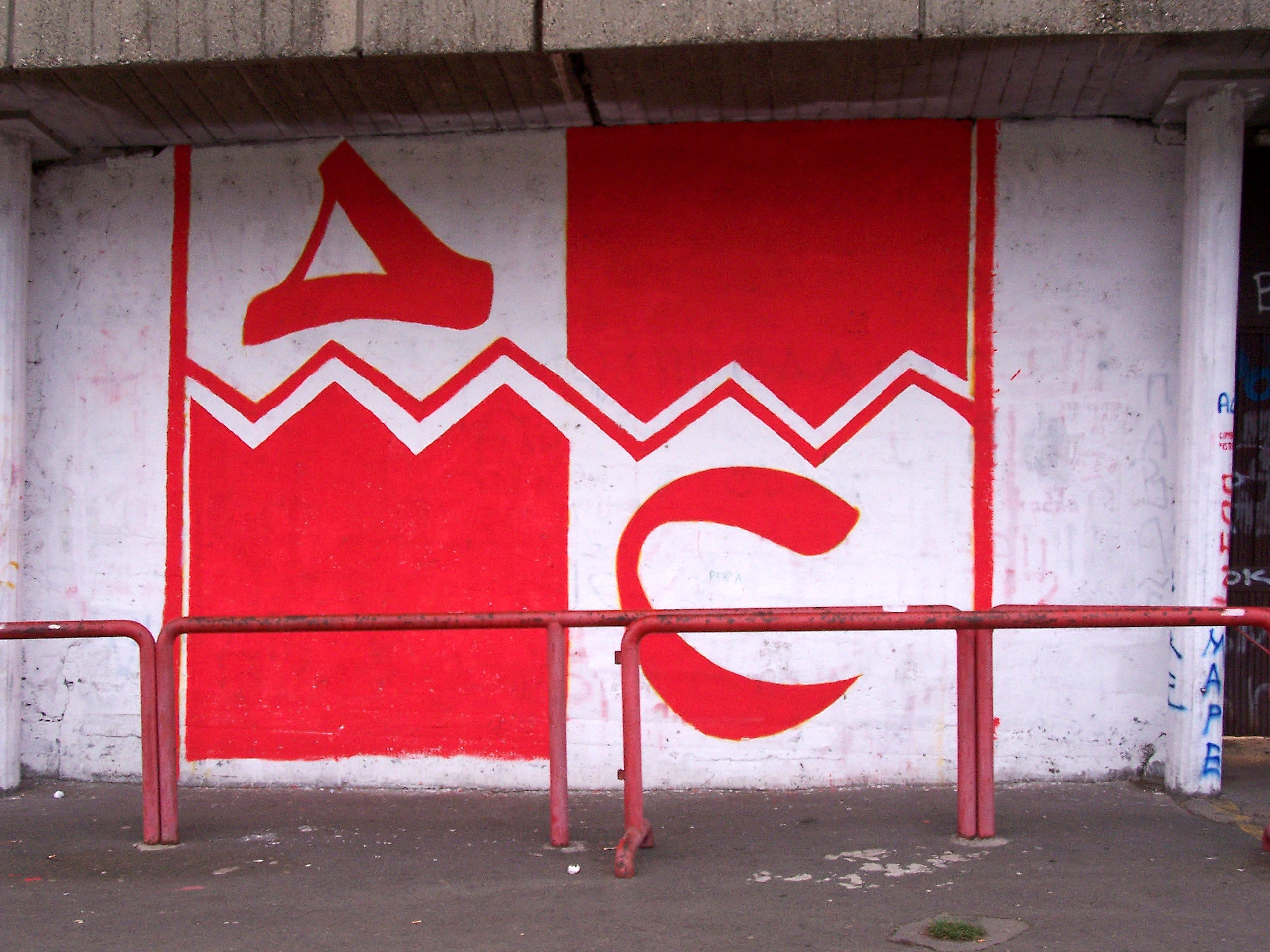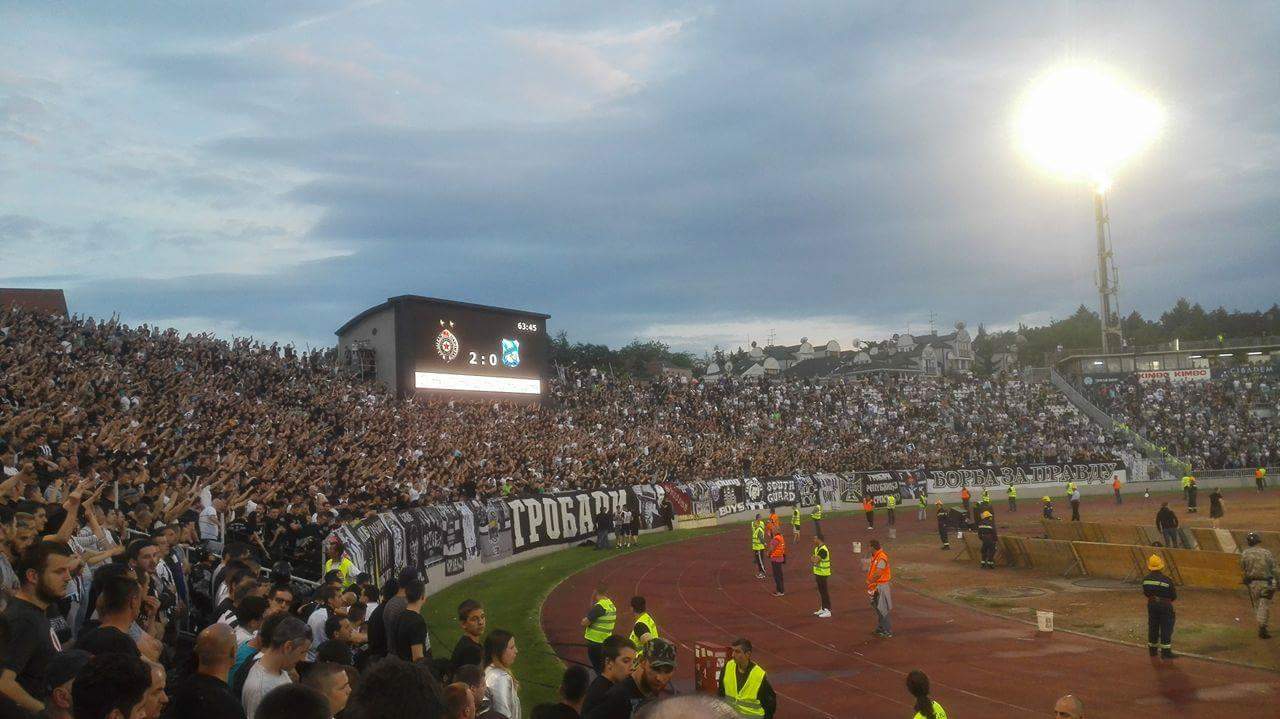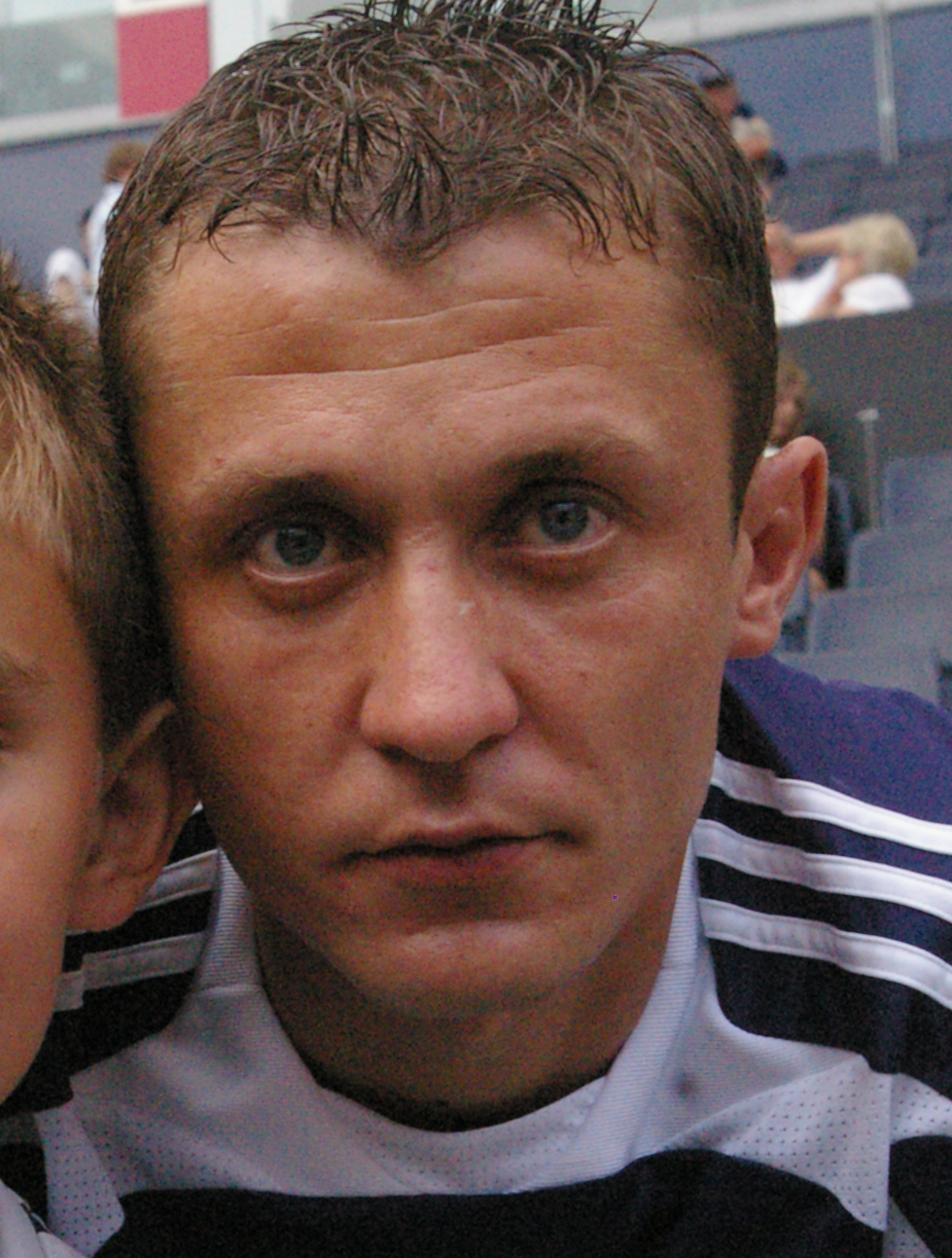|
1999–2000 First League Of FR Yugoslavia
The 1999–2000 First League of FR Yugoslavia was the eighth season of the FR Yugoslavia's top-level football league since its establishment. It was contested by 21 teams, and Red Star Belgrade won the championship. Incidents The season was marred by a tragic event on 30 October 1999, during the Partizan vs. Red Star tie (113th edition of the Večiti derbi) when seventeen-year-old Red Star fan Aleksandar "Aca" Radović from Opovo was killed by a signalling rocket fired from within the stadium. Radović, a third-year student at the First Belgrade Gymnasium, was supporting his team from the Partizan Stadium's north end when in 20th minute of the match he got hit in the chest by a flare gun-fired signaling rocket from the opposite end of the stadium, which is where Partizan fans were located. Partizan had just scored courtesy of Saša Ilić to go up 1-0 and, as a way of celebrating the goal, certain section of their ultra fans, Grobari, fired a series of ship-signalling rockets ... [...More Info...] [...Related Items...] OR: [Wikipedia] [Google] [Baidu] |
First League Of FR Yugoslavia
The First League of Serbia and Montenegro ( sr, Прва савезна лига / Prva savezna liga) was the top football league of Serbia and Montenegro, before the country's dissolution in 2006. The league was formed following the breakup of Yugoslavia in 1992, effectively succeeding the Yugoslav First League. The league was renamed the Serbia and Montenegro SuperLiga prior to its final 2005–06 season. From 1993 to 1998, the league abandoned the traditional single-league structure, which was used in the first season, and the division was split into two groups; Group A (known as IA) for the top-seeded teams and Group B (IB) for the other teams. Until 1995–96, the bottom four teams of the IA group were replaced with the top four teams of IB after the first half of the season, once all teams have played each other in their respective group twice. From 1996–97, the system of replacing teams in each group mid-season was scrapped and was only applied at the end of the season. ... [...More Info...] [...Related Items...] OR: [Wikipedia] [Google] [Baidu] |
Eternal Derby (Serbia)
The Eternal derby ( sr, Вечити дерби / Večiti derbi), also called the Derby of Southeast Europe and Belgrade derby ( sr, Београдски дерби / Beogradski derbi), is the local derby in Belgrade, capital of Serbia, between fierce city rivals Red Star Belgrade and Partizan Belgrade, two of the biggest and most popular clubs in Serbia. It has been described as "one of European football's most bitter rivalries". The rivalry is present in a number of different sports but the most intense matches are in football and basketball sections of both clubs. It started immediately after the creation of the two clubs in 1945 and the two clubs have been dominant in domestic football since then. According to a 2008 survey, Red Star is the most popular club in Serbia with 48% of the population supporting them. The second most popular is Partizan. They also have many supporters in Serbian Republic, Montenegro and Serbian diaspora. The football rivalry is highly regarde ... [...More Info...] [...Related Items...] OR: [Wikipedia] [Google] [Baidu] |
Mali Mokri Lug
Mali Mokri Lug ( sr-cyr, Мали Мокри Луг) is an urban neighborhood of Belgrade, Serbia. It is located in the south-eastern section of Belgrade's municipality of Zvezdara. It marks the border with the municipality of Grocka. It mostly stretches between Bulevar kralja Aleksandra and the Highway Belgrade–Niš, but also north of the boulevard ( Zeleno Brdo). It extends into the neighborhoods of Mirijevo on the north, Konjarnik on the west, Medaković III on the south-west, Veliki Mokri Lug on the south and Kaluđerica (in Grocka municipality) on the east. Geography Mali Mokri Lug occupies the northern section of the Mokroluški potok valley, which is today used as a route for the Belgrade-Niš highway and divides Mali Mokri Lug and Veliki Mokri Lug. The neighborhood occupies the southern slopes of several hills (Bajdina, Zeleno Brdo, Stojčino Brdo with an altitude of ), descending into the Mokroluški potok's valley, so the entire neighborhood is built downhill. ... [...More Info...] [...Related Items...] OR: [Wikipedia] [Google] [Baidu] |
Krnjača
Krnjača ( sr-cyr, Крњача, ) is an urban neighborhood of Belgrade, the capital of Serbia. It is located in Belgrade's municipality of Palilula. Location and population Krnjača is located on the left bank of the Danube, across the Belgrade proper, to which it is connected only by one bridge, the Pančevo Bridge. The settlement is built behind the long embankment along the Danube, but it is still often flooded by the river. Krnjača is much scattered and stretched along two major roads in this area, the ''Pančevački put'' which connects Belgrade to the city of Pančevo and ''Zrenjaninski put'' which connects Belgrade to the city of Zrenjanin. Krnjača is bordered by the Danube to the south, the ''Jojkićev Dunavac'' canal to the west and the '' Mokri Sebeš'' canal and the Veliko Blato bog to the north and east. The ''Kalovita'' canal flows through the middle of the neighborhood. Through Dunavski Venac, Krnjača makes an urban connection to Borča on the north and ... [...More Info...] [...Related Items...] OR: [Wikipedia] [Google] [Baidu] |
Aorta
The aorta ( ) is the main and largest artery in the human body, originating from the left ventricle of the heart and extending down to the abdomen, where it splits into two smaller arteries (the common iliac arteries). The aorta distributes oxygenated blood to all parts of the body through the systemic circulation. Structure Sections In anatomical sources, the aorta is usually divided into sections. One way of classifying a part of the aorta is by anatomical compartment, where the thoracic aorta (or thoracic portion of the aorta) runs from the heart to the diaphragm. The aorta then continues downward as the abdominal aorta (or abdominal portion of the aorta) from the diaphragm to the aortic bifurcation. Another system divides the aorta with respect to its course and the direction of blood flow. In this system, the aorta starts as the ascending aorta, travels superiorly from the heart, and then makes a hairpin turn known as the aortic arch. Following the aortic arch, the ... [...More Info...] [...Related Items...] OR: [Wikipedia] [Google] [Baidu] |
Throat
In vertebrate anatomy, the throat is the front part of the neck, internally positioned in front of the vertebrae. It contains the pharynx and larynx. An important section of it is the epiglottis, separating the esophagus from the trachea (windpipe), preventing food and drinks being inhaled into the lungs. The throat contains various blood vessels, pharyngeal muscles, the nasopharyngeal tonsil, the tonsils, the palatine uvula, the trachea, the esophagus, and the vocal cords. Mammal throats consist of two bones, the hyoid bone and the clavicle. The "throat" is sometimes thought to be synonymous for the fauces. It works with the mouth, ears and nose, as well as a number of other parts of the body. Its pharynx is connected to the mouth, allowing speech to occur, and food and liquid to pass down the throat. It is joined to the nose by the nasopharynx at the top of the throat, and to the ear by its Eustachian tube. The throat's trachea carries inhaled air to the bronchi of the lu ... [...More Info...] [...Related Items...] OR: [Wikipedia] [Google] [Baidu] |
Chest
The thorax or chest is a part of the anatomy of humans, mammals, and other tetrapod animals located between the neck and the abdomen. In insects, crustaceans, and the extinct trilobites, the thorax is one of the three main divisions of the creature's body, each of which is in turn composed of multiple segments. The human thorax includes the thoracic cavity and the thoracic wall. It contains organs including the heart, lungs, and thymus gland, as well as muscles and various other internal structures. Many diseases may affect the chest, and one of the most common symptoms is chest pain. Etymology The word thorax comes from the Greek θώραξ ''thorax'' " breastplate, cuirass, corslet" via la, thorax. Plural: ''thoraces'' or ''thoraxes''. Human thorax Structure In humans and other hominids, the thorax is the chest region of the body between the neck and the abdomen, along with its internal organs and other contents. It is mostly protected and supported by the rib cage, s ... [...More Info...] [...Related Items...] OR: [Wikipedia] [Google] [Baidu] |
Delije
Delije ( sr-cyr, Делије) is a name referring to the supporters of various sports clubs that compete under the Red Star Belgrade multi-sport club banner. The plural of the singular form ''delija'' (делија)—which in Serbian generally signifies a courageous, brave, strong, tough, or even handsome young man—a rough English translation of Delije is "Heroes", "Braves", or "Studs". Red Star multi-sport club has clubs in over twenty sports, although Delije mostly focus on football (FK Crvena zvezda) and basketball (KK Crvena zvezda). The name Delije first began to be used by hardcore Red Star supporters during the late 1980s, with official inauguration taking place on 7 January 1989. Up to that point, the die-hard fans were scattered amongst about eight groups that shared the north stand at the Rajko Mitić Stadium (known colloquially as Marakana), most prominent of which were the ''Red Devils'', ''Ultras'' and ''Zulu Warriors''. As a sign of appreciation, during the ... [...More Info...] [...Related Items...] OR: [Wikipedia] [Google] [Baidu] |
Grobari
Grobari (Serbian Cyrillic: Гробари, English: ''Gravediggers'' or ''Undertakers'') are the organized supporters group of the Serbian football club Partizan Belgrade. They are one of two major football fan groups in Serbia. They generally support all clubs within the Partizan multi-sports club, and mostly wear black and white symbols, which are the club's colors. Today, Grobari consist of three fractions: ''Južna tribina'', and ''Zabranjeni'', with various subgroups form the three larger ones. The group as a whole traditionally maintains good relations with the Greek PAOK football club supporters '' Gate 4'' as well as with the fans of Russian CSKA Moscow, Italian AC Milan, Romanian Steaua București and Bulgarian CSKA Sofia. History First groups of organized Partizan fan supporters began to visit the JNA stadium in the late 1950s. Those were mainly young men from Belgrade, and they occupied southern stands of the stadium. In those times, support was expressed by ... [...More Info...] [...Related Items...] OR: [Wikipedia] [Google] [Baidu] |
Saša Ilić (footballer, Born 1977)
Saša Ilić (, ; born 30 December 1977) is a Serbian professional football coach and a former player who played as an attacking midfielder. He is the current manager of CSKA Sofia. After spending more than 20 years at Partizan, both youth and senior teams, Ilić became the most capped player in the club's history with more than 800 appearances (official and friendlies). He won 18 trophies with the ''Crno-beli'', including 11 national championship titles and seven national cups. Additionally, Ilić is Partizan's most capped player in European club competitions with 113 appearances. At international level, Ilić was capped for his country under three different names, between 2000 and 2008, making a total of 37 appearances to his name. He represented Serbia and Montenegro at the 2006 FIFA World Cup. Club career Partizan Born in Požarevac, Ilić initially came to Partizan in 1986 when his father Milan took him to a training session led by Florijan Matekalo. He was officially reg ... [...More Info...] [...Related Items...] OR: [Wikipedia] [Google] [Baidu] |
Flare Gun
A flare gun, also known as a Very pistol or signal pistol, is a large-bore handgun that discharges flares, blanks and smoke. The flare gun is typically used to produce a distress signal. Types The most common type of flare gun is a Very (sometimes spelled Verey), which was named after Edward Wilson Very (1847–1910), an American naval officer who developed and popularized a single-shot breech-loading snub-nosed pistol that fired flares (Very lights). They have a single action trigger mechanism, hammer action, and a center fire pin. Modern varieties are frequently made out of durable plastic of a bright colour that makes them more conspicuous and easier to retrieve in an emergency and assists in distinguishing them from conventional firearms. The Very pistol, typical of the type used in the Second World War, are of one inch bore (26.5mm), now known as "Calibre 4" for signal pistols. These are still available and more recent longer barrel models can also fire parachute fl ... [...More Info...] [...Related Items...] OR: [Wikipedia] [Google] [Baidu] |
Partizan Stadium
The Partizan Stadium (Serbian: Стадион Партизанa / ''Stadion Partizana'') is a football and track-and-field stadium in Autokomanda, Belgrade, Serbia. The home ground of FK Partizan, it was formerly known as JNA Stadium (Stadion JNA / Стадион ЈНА) after the Yugoslav People's Army (JNA), which it is still colloquially known as by fans in the former SFR Yugoslavia. Its current capacity is 29,775, having previously seated 50,000 people before conversion to an all-seater stadium. History Construction of the stadium was started after World War II, on the site of BSK Stadion, which was a 25,000-seat stadium that hosted the Yugoslav national team as well as BSK Beograd. The stadium was built with the help of the Yugoslav People's Army, in the period between 1948 and 1951. Although the stadium was not completely finished, the first match was Yugoslavia against France on 9 October 1949, which ended 1–1. The ground was officially opened on Yugoslav People's ... [...More Info...] [...Related Items...] OR: [Wikipedia] [Google] [Baidu] |








